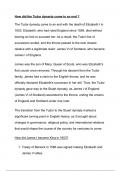How did the Tudor dynasty come to an end ?
The Tudor dynasty came to an end with the death of Elizabeth I in
1603. Elizabeth, who had ruled England since 1558, died without
leaving an heir to succeed her. As a result, the Tudor line of
succession ended, and the throne passed to the next closest
relative with a legitimate claim: James VI of Scotland, who became
James I of England.
James was the son of Mary, Queen of Scots, who was Elizabeth's
first cousin once removed. Through his descent from the Tudor
family, James had a claim to the English throne, and he was
officially declared Elizabeth's successor in her will. Thus, the Tudor
dynasty gave way to the Stuart dynasty, as James I of England
(James VI of Scotland) ascended to the throne, uniting the crowns
of England and Scotland under one ruler.
The transition from the Tudor to the Stuart dynasty marked a
significant turning point in English history, as it brought about
changes in governance, religious policy, and international relations
that would shape the course of the country for centuries to come.
How did James I become King in 1603?
1. Treaty of Berwick in 1586 was signed making Elizabeth and
James Vi allies.
, 2. March 1603 Queen Elizabeth died with no children as an heir
to the throne.
3. After her death, according to Henry VIII, Lady Anne Stanley
should have become Queen.
4. Elizabeth chose James to be her heir as he was already King
of Scotland.
5. Due to James being a direct descendent to Henry Vil this
would make him Elizabeth's nearest royal relative.
6. Although his surname was Stuart this brought the Tudor
dynasty to an end.
James I became King of England in 1603 through the process of
inheritance and succession. Here's how it happened:
Death of Elizabeth I: Queen Elizabeth I of England died on
March 24, 1603, without leaving an heir to succeed her.
Elizabeth was the last monarch of the Tudor dynasty, and her
death marked the end of Tudor rule in England.
James VI of Scotland's Claim: James VI of Scotland, who
was also known as James Stuart, was the son of Mary, Queen
of Scots, and the great-great-grandson of Henry VII of
England through his maternal grandmother, Margaret Tudor.
As Elizabeth's closest living relative with a legitimate claim to
the English throne, James was declared Elizabeth's successor
in her will.
, James's Accession: Upon Elizabeth's death, James VI of
Scotland was proclaimed King of England as James I on
March 24, 1603. He became the first monarch to rule both
England and Scotland, uniting the crowns of the two kingdoms
in what became known as the Union of the Crowns.
Coronation: James I was formally crowned as King of
England on July 25, 1603, in a lavish coronation ceremony at
Westminster Abbey. The coronation symbolised his official
ascension to the English throne and the beginning of the
Stuart dynasty in England.
James I's accession to the English throne brought about significant
changes in governance, religion, and foreign policy, as England and
Scotland were now ruled by the same monarch. His reign marked
the beginning of a new era in English history and set the stage for
the Stuart monarchy's rule in England.
What problems did King James I have with Parliament?
King James I of England faced several challenges and conflicts with
Parliament during his reign. Some of the key problems he
encountered include:
Financial Issues: King James I struggled with financial
management and often faced budget deficits. He relied heavily
on parliamentary subsidies and grants to fund his government




